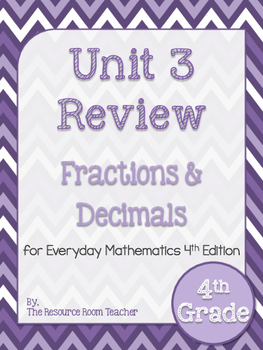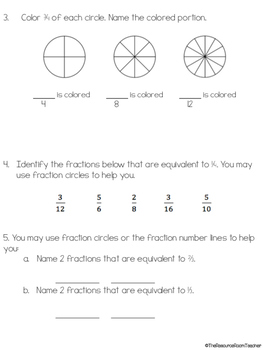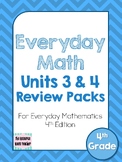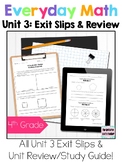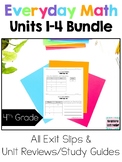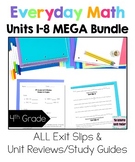4th Grade Everyday Math Unit 3 Review/Study Guide - 4th Edition
The Resource Room Teacher
1.5k Followers
Resource Type
Standards
CCSS4.MD.A.1
CCSS4.NBT.B.5
CCSS4.NF.A.1
CCSS4.NF.A.2
CCSS4.NF.C.6
Formats Included
- PDF
Pages
10 pages
The Resource Room Teacher
1.5k Followers
Also included in
- Are you looking for a way for your 4th grade students to review the topics covered in Unit 3 and Unit 4 of Everyday Math? This review/study guide is just what you need! *Answer key included!This review is based on the 4th edition of the Everyday Math program for 4th grade.**Get the Bundle Packs &Price $4.50Original Price $6.00Save $1.50
- This bundle pack is full of supplemental materials for 4th Grade Everyday Math Unit 3 (4th Edition)! This resource includes 14 Exit Slips, covering each individual topic in Unit 3 (topics listed below), and an end of unit review (that could also be used as a clear and organized replacement for the aPrice $5.50Original Price $6.50Save $1.00
- This huge bundle pack is full of supplemental materials for 4th Grade Everyday Math Units 1-4 (4th Edition)! This resource includes over 40 Exit Slips, covering each individual topic in Units 1-4 (topics listed below), and 4 end of unit reviews (that could also be used as a clear and organized replaPrice $17.00Original Price $26.00Save $9.00
- Are you looking for a way to check in with your students throughout each unit of Everyday Math? Would your students benefit from reviewing the topics covered in Units 1-8 of Everyday Math before each assessment? This mega bundle is just what you need! *All answer keys included!*Want to try before yoPrice $29.99Original Price $52.50Save $22.51
Description
Are you looking for a way for your 4th grade students to review the topics covered in Unit 3 of Everyday Math? This review/study guide is just what you need! *Answer key included!
This review is based on the 4th edition of the Everyday Math program for 4th grade.
**Get the Bundle Packs & SAVE!:
4th Grade Units 1-4 EDM Review BUNDLE PACK
4th Grade Units 5-8 EDM Review BUNDLE PACK
4th Grade Everyday Math Units 1-8 MEGA BUNDLE! *Best price! Less than $2 per review!*
Unit 1:
Unit 2:
Unit 4:
Unit 5:
Unit 6:
Unit 7:
Unit 8:
Total Pages
10 pages
Answer Key
Included
Teaching Duration
N/A
Report this resource to TPT
Reported resources will be reviewed by our team. Report this resource to let us know if this resource violates TPT’s content guidelines.
Standards
to see state-specific standards (only available in the US).
CCSS4.MD.A.1
Know relative sizes of measurement units within one system of units including km, m, cm; kg, g; lb, oz.; l, ml; hr, min, sec. Within a single system of measurement, express measurements in a larger unit in terms of a smaller unit. Record measurement equivalents in a two-column table. For example, know that 1 ft is 12 times as long as 1 in. Express the length of a 4 ft snake as 48 in. Generate a conversion table for feet and inches listing the number pairs (1, 12), (2, 24), (3, 36),...
CCSS4.NBT.B.5
Multiply a whole number of up to four digits by a one-digit whole number, and multiply two two-digit numbers, using strategies based on place value and the properties of operations. Illustrate and explain the calculation by using equations, rectangular arrays, and/or area models.
CCSS4.NF.A.1
Explain why a fraction 𝘢/𝘣 is equivalent to a fraction (𝘯 × 𝘢)/(𝘯 × 𝘣) by using visual fraction models, with attention to how the number and size of the parts differ even though the two fractions themselves are the same size. Use this principle to recognize and generate equivalent fractions.
CCSS4.NF.A.2
Compare two fractions with different numerators and different denominators, e.g., by creating common denominators or numerators, or by comparing to a benchmark fraction such as 1/2. Recognize that comparisons are valid only when the two fractions refer to the same whole. Record the results of comparisons with symbols >, =, or <, and justify the conclusions, e.g., by using a visual fraction model.
CCSS4.NF.C.6
Use decimal notation for fractions with denominators 10 or 100. For example, rewrite 0.62 as 62/100; describe a length as 0.62 meters; locate 0.62 on a number line diagram.

